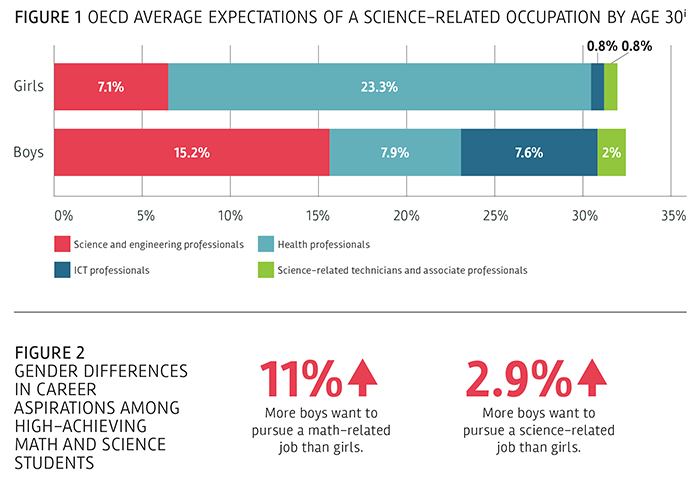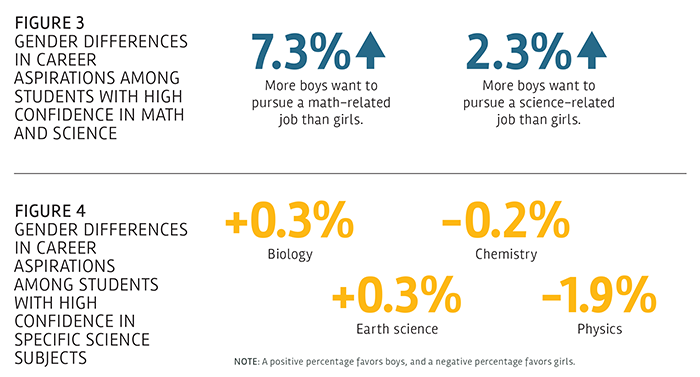High performance in science and math does not always correlate to girls’ intentions to pursue STEM careers.
By Roberta Rincon, Ph.D., SWE Associate Director of Research
International assessments highlight the stark difference between girls’ and boys’ aspirations to pursue a career in science, technology, engineering, and math (STEM). Figure 1 shows that both girls and boys in more than 40 countries that are part of the Organisation for Economic Co-operation and Development (OECD)ii are similarly interested in science-related careers, but twice as many boys as girls (15.2% vs. 7.1%, respectively) report that they expect to work in science and engineering careers. Meanwhile, girls are more likely to expect to be working in the health professions (23.3% of girls vs. 7.9% of boys). And less than 1% of girls report an interest in working in the information and communications technology (ICT) professions, compared to 8% of boys.
Researchers from the International Association for the Evaluation of Educational Achievement (IEA),iii in partnership with the United Nations Educational, Scientific, and Cultural Organization (UNESCO),iv recently analyzed global educational assessment data for students in grade 8 to understand the relationship between confidence and achievement in mathematics and science and their aspirations to pursue a STEM career. Comparing international averages by gender across 45 educational systems,v researchers discovered that for both girls and boys, high confidence in math or science skills is associated with a higher desire to enter a math- or science-related job. However, boys were much more likely to report high confidence in math skills than girls, while science confidence varied by subject. For example, in biology and chemistry, girls often reported higher confidence than boys, whereas in physics, boys in most countries reported significantly higher confidence than girls.
When comparing career aspirations among high-performing students by gender, other glaring differences emerge. Within high-performing math achievers, boys reported more often than girls that they were interested in pursuing a math-related career (Figure 2). Within high-performing science achievers, there was a small, yet still significant, difference between genders.
For students with high confidence in math, boys reported more often than girls that they were interested in pursuing a math-related career (Figure 3). For students with high confidence in science, researchers saw only a small difference in career aspirations between genders.
Though we have seen improvements in math and science performance for girls, with gender achievement gaps closing over time, girls are still choosing not to pursue STEM careers — particularly careers in math, physics, engineering, and technology.
When looking at separate science subjects, researchers found no statistically significant difference between boys and girls with high confidence in biology, chemistry, and earth science in their aspirations to pursue a science career (Figure 4). For physics, they discovered that girls with high confidence more often reported interest in pursuing a science job than boys, and this difference was statistically significant.
The IEA researchers emphasized the need to address the confidence of girls in math and science. Though we have seen improvements in math and science performance for girls, with gender achievement gaps closing over time, girls are still choosing not to pursue STEM careers — particularly careers in math, physics, engineering, and technology. Reducing gender stereotypes, offering more women as STEM role models, and introducing STEM activities and career options at an early age could help inspire more girls to consider a STEM career.
i OECD (2019b), PISA 2018 Results (Volume II): Where All Students Can Succeed.
ii The Organisation for Economic Co-operation and Development (OECD) is an international organization that seeks to establish evidence-based international standards and solutions to global social, economic, and environmental challenges.
iii Hencke, J., Eck, M., Sass, J., Hastedt, D., & Mejia-Rodriguez, A. (2022, April). Missing out on half of the world’s potential: Fewer female than male top achievers in mathematics and science want a career in these fields. IEA Compass: Briefs in Education No. 17. Amsterdam, The Netherlands: IEA.
iv The United Nations Educational, Scientific, and Cultural Organization (UNESCO) promotes world peace and security through international cooperation.
v 38 countries and 7 distinct educational systems within countries.
Editor’s note: Please visit the SWE research site for the latest studies and statistics on women in engineering and STEM: swe.org/research.



